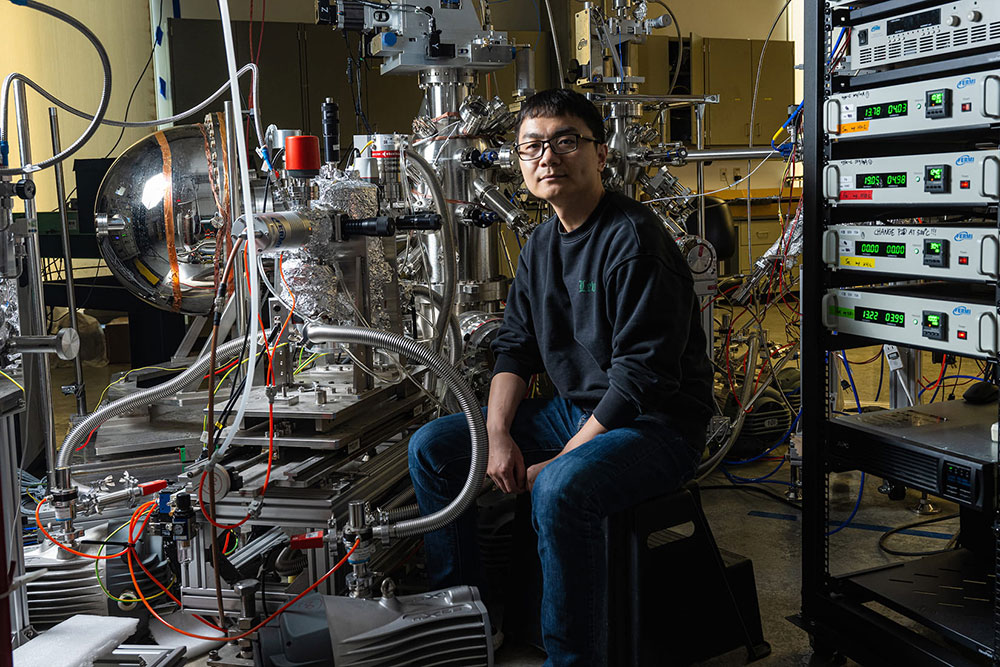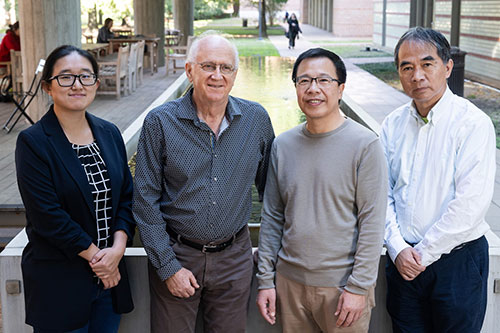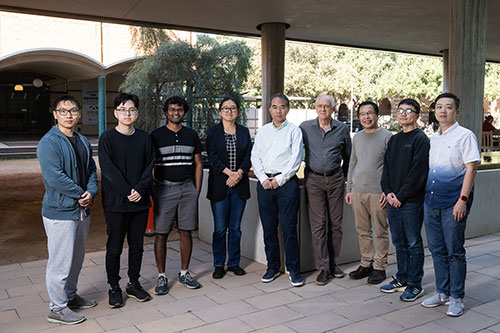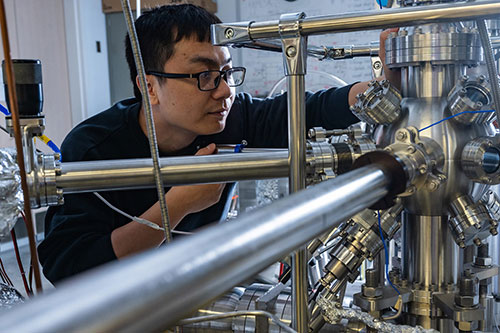Rice Scientists Pull Off Quantum Coup
Study validates method for guided discovery of 3D flat-band materials
February 14, 2024
By Jade Boyd
 enlarge
enlarge
Rice University postdoctoral research associate Jianwei Huang with the laboratory apparatus he used to conduct angle-resolved photoemission spectroscopy experiments on a copper-vanadium alloy. The experiments showed the alloy is the first known material in which 3D crystal structure and strong quantum interactions frustrate the movement of electrons and lock them in place, resulting in a flat electronic band. (Photo by Jeff Fitlow/Rice University)
The following feature story was originally issued by Rice University. Beamline scientists Elio Vescovo and Turgut Yilmaz collaborated on angle-resolved photoemission spectroscopy measurements of the 3d pyrochlore metal CuV2S4 to learn more about its electronic properties using the Electron Spectro-Microscopy (ESM) beamline at the National Synchrotron Light Source II (NSLS-II), a U.S. Department of Energy (DOE) Office of Science User Facility at DOE’s Brookhaven National Laboratory. For more information on Brookhaven’s role in this research, contact Denise Yazak (dyazak@bnl.gov, 631-344-6371).
Rice University scientists have discovered a first-of-its-kind material, a 3D crystalline metal in which quantum correlations and the geometry of the crystal structure combine to frustrate the movement of electrons and lock them in place.
The find is detailed in a study published in Nature Physics. The paper also describes the theoretical design principle and experimental methodology that guided the research team to the material. One part copper, two parts vanadium and four parts sulfur, the alloy features a 3D pyrochlore lattice consisting of corner-sharing tetrahedra.
 enlarge
enlarge
A collaboration between Rice University research groups led by (left to right) Ming Yi, Boris Yakobson, Qimiao Si and Pengcheng Dai led to the discovery of a first-of-its-kind material, a copper-vanadium alloy in which strong quantum interactions and 3D crystal structure combine to frustrate electron movement, producing a flat electronic band. (Photo by Jeff Fitlow/Rice University)
“We look for materials where there are potentially new states of matter or new exotic features that haven’t been discovered,” said study co-corresponding author Ming Yi, a Rice experimental physicist.
Quantum materials are a likely place to look, especially if they host strong electron interactions that give rise to quantum entanglement. Entanglement leads to strange electronic behaviors, including frustrating the movement of electrons to the point where they become locked in place.
“This quantum interference effect is analogous to waves rippling across the surface of a pond and meeting head-on,” Yi said. “The collision creates a standing wave that does not move. In the case of geometrically frustrated lattice materials, it’s the electronic wave functions that destructively interfere.”
Electron localization in metals and semimetals produces flat electronic bands, or flat bands. In recent years, physicists have found that the geometric arrangement of atoms in some 2D crystals, like Kagome lattices, can also produce flat bands. The new study provides empirical evidence of the effect in a 3D material.
Using an experimental technique called angle-resolved photoemission spectroscopy, or ARPES, Yi and study lead author Jianwei Huang, a postdoctoral researcher in her lab, detailed the band structure of the copper-vanadium-sulfur material and found it hosted a flat band that is unique in several ways.
“It turns out that both types of physics are important in this material,” Yi said. “The geometric frustration aspect was there, as theory had predicted. The pleasant surprise was that there were also correlation effects that produced the flat band at the Fermi level, where it can actively participate in determining the physical properties.”
In solid-state matter, electrons occupy quantum states that are divided in bands. These electronic bands can be imagined as rungs on a ladder, and electrostatic repulsion limits the number of electrons that can occupy each rung. Fermi level, an inherent property of materials and a crucial one for determining their band structure, refers to the energy level of the highest occupied position on the ladder.
Rice theoretical physicist and study co-corresponding author Qimiao Si, whose research group identified the copper-vanadium alloy and its pyrochlore crystal structure as being a possible host for combined frustration effects from geometry and strong electron interactions, likened the discovery to finding a new continent.
“It’s the very first work to really show not only this cooperation between geometric- and interaction-driven frustration, but also the next stage, which is getting electrons to be in the same space at the top of the (energy) ladder, where there’s a maximal chance of their reorganizing into interesting and potentially functional new phases,” Si said.
He said the predictive methodology or design principle that his research group used in the study may also prove useful to theorists who study quantum materials with other crystal lattice structures.
“The pyrochlore is not the only game in town,” Si said. “This is a new design principle that allows theorists to predictively identify materials in which flat bands arise due to strong electron correlations.”
Yi said there is also plenty of room for further experimental exploration of pyrochlore crystals.
 enlarge
enlarge
Rice University researchers (left to right) Yuefei Huang, Lei Chen, Chandan Setty, Ming Yi, Pengcheng Dai, Boris Yakobson, Qimiao Si, Jianwei Huang and Bin Gao collaborated on the discovery of a first-of-its-kind material, a copper-vanadium alloy in which strong quantum interactions and 3D crystal structure combine to frustrate electron movement, producing a flat electronic band. (Photo by Jeff Fitlow/Rice University)
“This is just the tip of the iceberg,” she said. “This is 3D, which is new, and just given how many surprising findings there have been on Kagome lattices, I’m envisioning that there could be equally or maybe even more exciting discoveries to be made in the pyrochlore materials.”
The research team included 10 Rice researchers from four laboratories. Physicist Pengcheng Dai’s research group produced the many samples needed for experimental verification, and Boris Yakobson’s research group in the Department of Materials Science and NanoEngineering performed first-principle calculations that quantified the flat-band effects produced by geometric frustration. ARPES experiments were conducted at Rice and at the SLAC National Accelerator Laboratory’s Stanford Synchrotron Radiation Lightsource in California and Brookhaven National Laboratory’s National Synchrotron Light Source II in New York, and the team included collaborators from SLAC, Brookhaven and the University of Washington.
The research used resources supported by a Department of Energy (DOE) contract to SLAC (DE-AC02-76SF00515) and was supported by grants from the Gordon and Betty Moore Foundation’s Emergent Phenomena in Quantum Systems Initiative (GBMF9470), the Robert A. Welch Foundation (C-2175, C-1411, C-1839), the DOE’s Office of Basic Energy Sciences (DE-SC0018197), the Air Force Office of Scientific Research (FA9550-21-1-0343, FA9550-21-1-0356), the National Science Foundation (2100741), the Office of Naval Research (ONR) (N00014-22-1-2753) and the ONR-managed Vannevar Bush Faculty Fellows program of the Department of Defense Basic Research Office (ONR-VB N00014-23-1-2870).
2024-21723 | INT/EXT | Newsroom










